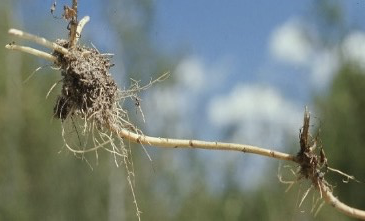Story and photos by Diana Westland, Mississauga Master Gardeners
Goldenrod is a keystone plant. Keystone plants are native plants critical for wildlife food. Without keystone plants in the landscape, butterflies, native bees, and birds will not thrive. Many birds in our region rely on insects that rely on keystone plants for food. Keystone host plants feed the young caterpillars of approximately 90% of butterflies and moths (Lepidoptera) (NWF). Keystone plants also feed specialist bees who only eat pollen from specific plants. Keystone plants for native bees feed both specialist and generalist bees.

The genus Solidago or goldenrod, is part of the family Asteraceae and has a number of different species. According to the United States National Wildlife Federation, goldenrods are part of the 30 top keystone host plants for Lepidoptera (caterpillars), supporting 104 species that will eventually becomes moths and butterflies. The caterpillars are also important protein sources for many birds, especially for their young. Goldenrod are also within the top 30 host plants for pollen specialist bees, supporting 42 bee species.
A goldenrod species for every space
There are a wide variety of goldenrod species that cover all environments. They provide color and food in late summer and early fall, and are excellent pairings with the blue-purple asters, pink Joe Pye weed, and white turtlehead, which bloom at the same time. Fall blooming flowers are especially important to ensure that pollinators such as bumblebee queens have the energy they need before going into hibernation. Late blooms are also important for migrating species such as monarch butterflies who need to stock up on energy for their trip to Mexico. Small birds such as finches will eat the goldenrod seeds in winter.

Goldenrod is often blamed for allergic symptoms actual caused by ragweed pollen. The goldenrod pollen is heavy and does not travel far from the plant, and is therefore seldom the cause of fall allergies. It blooms at the same time as ragweed (ambrosia).
Right: Ragweed. Source: Ragweed - Wikiwand.
Goldenrod leaves are alternate along the stem with shapes and features varying among species. Flowers are very small, typically yellow, forming dense clusters (inflorescences). The shape of the inflorescences vary from flat topped, pyramidal, wand or club shaped, or small clusters near the leaf axils. The plant propagates by both seed and rhizome. Soil and sun needs vary widely between species.
1. Canada goldenrod Solidago canadensis
Many are familiar with the Canada goldenrod with its pyramidal shaped flower cluster at the top of the plant. This species can reach 4 ft high in good conditions and prefer average to moist soil in sun. Leaves are toothed, hairy beneath, and lance like and have three parallel veins.
Below: I also cut the top third of the plant in early summer when it is roughly 2 ft high to control the height. The rhizomes tend to be shallow, and I have found the young plants to be easy to remove in early spring.
2. Roughstem or wrinkeleaf goldenrod S. rugosa
This is another common goldenrod found in moister soils in sun. Flowers are on narrow arching racemes with rough ovate leaves with the vein pattern imbedded. Stems are hairy. Plants can reach 5 ft.
3. Giant or smooth goldenrod S. gigantea
This goldenrod has a distinctive smooth stem varying from green to reddish. Leaves are smooth with toothed edges. This goldenrod prefers moist soil and sun. Flower clusters are concentrated at the top.
Photos: Left - shows a late bloomer due to the removal of the top third of the plant midsummer. Otherwise these plants can reach 6 ft high. Right - Note the reddish stems and leaf showing three parallel veins.
For the smaller gardens several goldenrod species are available in our region that do not spread as aggressively. Seed germination can be further slowed by close planting with other plants. These species include zigzag goldenrod (Solidago flexicaulis), bluestem goldenrod (Solidago caesia), stiff goldenrod (Solidago rigida), and gray goldenrod (Solidago nemoralis):
4. Zigzag goldenrod S. flexicaulis
This woodland goldenrod grows up to 3 ft high in part to full shade. The leaves are broad and course toothed. The yellow flowers are fragrant in wand-like racemes on the upper stem. Note the characteristic stem direction change between nodes.

5. Bluestem goldenrod S. caesia
Another woodland goldenrod, stems of S. caesia can form a very ornamental 3 ft high mound in part or full shade. Flowers are on arching purple/blue stems, emerging from the leaf axils. Photo ©2021 Jeanne McRight

6. Stiff goldenrod S. rigida
Stiff goldenrod prefers full sun and grows up to 2-5 ft high. It has large, fuzzy rounded oval leaves with a hairy stem, and a flat topped flower cluster. Photos ©2022 Jeanne McRight.
7. Grey goldenrod S. nemoralis
This goldenrod grows up to 2 ft high in full sun and is the shortest Ontario goldenrod. The stems are hairy and grey with narrow grey-green leaves. Flowers are on top of the branching stalks.
Goldenrod is very important to supporting the native wildlife in Ontario. I encourage everyone to try to find some space in their gardens to nurture and appreciate these plants.
Sources:
Shaun Booth, November 5 2020, Native Goldenrods for Ontario Gardens, www.inournature.ca/goldenrods-for-ontario-gardens
The National Wildlife Foundation, Keystone Plants by Ecoregion, www.nwf.org/Garden-for-Wildlife/About/Native-Plants/keystone-plants-by-ecoregion
More info:
Guidotti, Antonia (2021). Insect Migrations. ROM Magazine, Royal Ontario Museum https://www.rom.on.ca/en/collections-research/magazine/insect-migrations
Craig, Elizabeth (2021). Fields of Gold Plant Goldenrod for Specialist Bees and Migrating Monarchs. Pollinator Pathway https://www.pollinator-pathway.org/post/fields-of-gold-plant-goldenrod-for-specialist-bees-and-migrating-monarchs
Narango, D.L., Tallamy, D.W. & Shropshire, K.J. Few keystone plant genera support the majority of Lepidoptera species. Nat Commun 11, 5751 (2020). https://doi.org/10.1038/s41467-020-19565-4




















Commentaires